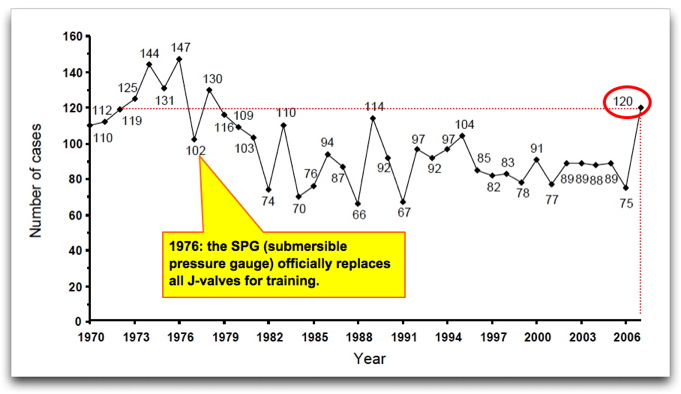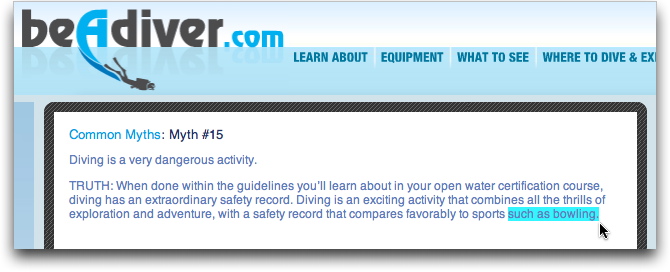Well! I just got off of the phone after speaking with a representative of CanarySense.com. They are an autherized retailer for BW Technologies analyzers. Here is what I have learned thus far:
1) Bw Technologies is a Canadian based subsidiary of Honeywell.
2) They recommend that you calibrate your unit with a 100 ppm CO gas (which they will gladly sell to you at a cost of $140).
3) Oh, and by-the-way, you will need a regulator to hook up to that bottle of calibration gas!... Uh, that's another $150!.... See where this is going yet? :depressed:
4) Now the analyzer itself will set you back $265. It is, however, calibrated at the time you receive it. So (as the rep was quick to point out!), you can deffer the cost of regulator and calibration gas for a "few months" if you so desire.... Bottom line: You will be out those costs eventually!
5) They have no adapters/methods for testing directly from a SCUBA tank. Therefore, you are relegated to purging gas into a Zip-lock bag, or what ever alternative method you can come up with!
6) When it is all said and done, you will have forked out $550 for the analyzer and equipment to calibrate it!
Wow!!! Seems steep to me! Surely there is a more "palatable" approach to this problem! Much as I am in favor of testing my tanks, I know I would have a hard time dropping that sort of money on a single gas analyzer!
I think if you do a little more digging you will see that this is a worst case scenario and that the cost of purchasing a ToxiRae 3 with equivalent supply of calibration gas is identical to the Pocket CO and you will have a far superior monitor that is calibrated at 10 ppm CO rather than 100 ppm which will give poor accuracy when trying to measure CO contamination in the < 10 ppm range.
Here's how:
ToxiRae 3
ToxiRae 3 $150 from a distributor in Utah according to Scared Silly
0.5 lpm regulator for 17 L tank $96
GASCO - 72-MFV/17 Mini Valve and Flow Meter
17 litres 10 ppm CO/balance air $45 (this will provide
34 calibrations or fewer calibrations and a supply of bump gas for verifying the accuracy each day before use)
GASCO Non-Reactive Single & Two Gas Mixtures - Carbon Monoxide
Flow restrictor for BCD lp hose $31
BC Connector for Gas Analysis [GA-BC-Flow] - $30.45 : Tech Diving Limited, a subsidiary of Scuba Training and Technology Inc.
Total $322
Pocket CO
Unit with only 3 calibrations and no bump gas potential to verify accuracy $199
Calibration gas for 3 additional years done 3x per year $120
Total $319
Other properties to consider:
1) Analysis time
Time to take a reading known as T90 or time to reach 90 % of true concentration
ToxiRae 3 : 15 seconds
BWT Gas Alert Extreme : 30 seconds
Pocket CO : 3 minutes in bag
If one needs to check multiple tanks the ToxiRae 3 is the way to go due to its very fast sensor
2) Calibration gas concentration
With the ToxiRae 3 and BWT Gas Alert Extreme one can change the calibration gas concentration from 5 ppm to 50 ppm. In order to have high accuracy in the 0 to 10 ppm range these detectors must be calibrated at 10 ppm not 100 ppm as found with the Pocket CO.
3) Water-resistance
Both the ToxiRae 3 and BW Tech units are splash proof and will withstand immersion to one metre for one minute.
The Pocket CO has no IP rating and is not splash proof as the air intake ports communicate directly with the printed circuit board and battery. If this unit falls in salt water it will be ruined.
4) Cross-reacting gases
Each unit will react to NO, H2, and H2S and give false positive ratings. The Pocket CO reacts to far more cross-reacting gases which is a problem if one is challenging a fill station owner yet the contaminant is simply NO and not CO.
Given the cost of ownership over 4 years is the same between the Pocket CO and ToxiRae 3 the latter is a better value especially considering one will also have 22 litres of calibration gas remaining for daily bump checks.
For Canadians the calgas, regulator, and portables can be purchased from
Concept Controls Ask for Dave at the Mississauga office.
While the 10 ppm CO calgas may not be listed it is a stock product from Gasco.






